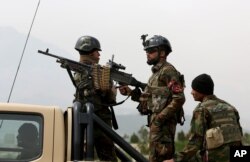The United Nations said the Afghan conflict has caused nearly 2,000 casualties in the first three months of this year, showing an increase of 2 percent compared to the same period last year.
The number includes an increase of 11 percent in civilians wounded – 1,343 – but a decrease of 13 percent in those killed – 600.
The fighting has intensified in Afghanistan since the Taliban announced the start of its annual spring offensive last Tuesday, raising fears of increased bloodshed in 2016.
U.N. Assistance Mission in Afghanistan (UNAMA) chief Nicholas Haysom called on all parties to the Afghan conflict to take precautions to protect civilians during operations.
“Even if a conflict intensifies, it does not have to be matched by corresponding civilian suffering provided parties take their international humanitarian law and human rights obligations seriously,” Haysom said.
UNAMA recorded more than 11,000 civilian casualties, including 3,500 deaths in 2015, the highest numbers since it began documenting the data seven years ago.
Taliban blamed
While releasing the latest civilian casualty figures on Sunday, UNAMA blamed the Taliban-led anti-government forces for causing at least 60 percent of the casualties.
The figures, however, show a 15 percent decrease compared to the same period last year.
UNAMA attributed 19 percent of the casualties to actions by Afghan government forces and their allies, noting with concern a 70 percent increase compared to the first three months of 2015.
It documented a 5 percent increase in women casualties and a 29 percent increase in child casualties compared to the same period last year.
“In the first quarter of 2016, almost one-third of civilian casualties were children,” said Danielle Bell, UNAMA’s Human Rights Director.
Ground engagements caused the highest number of civilian casualties, followed by improvised explosive devices (IEDs), complex and suicide attacks, as well as targeted killings, according to UNAMA.
The U.N. Mission welcomed the decrease in civilian casualties so far this year from insurgent tactics such as targeted killings of Afghans and IED attacks. But it noted with concern a 26 percent increase in civilian casualties from complex and suicide attacks, calling on the insurgents to cease such activities.
Aerial operations
UNAMA said it is particularly worried over a rise in civilian casualties this year from aerial operations by both the Afghan Air Force and international-led military forces, mostly Americans.
Their actions have killed six people and wounded 21 compared to 16 civilian casualties during the same period in 2015.
The Mission said 16 percent of civilian casualties could not be attributed to a specific party, and blamed unattributed unexploded ordinance for 6 percent of casualties.
UNAMA called on the Afghan government to restrict the use of explosive weapons such as mortars, rockets and grenades during ground engagement with insurgents, saying they killed 96 civilians and wounded 192.
The UNAMA figures showed an 85 percent increase by such weapons compared to the first quarter of 2015.














